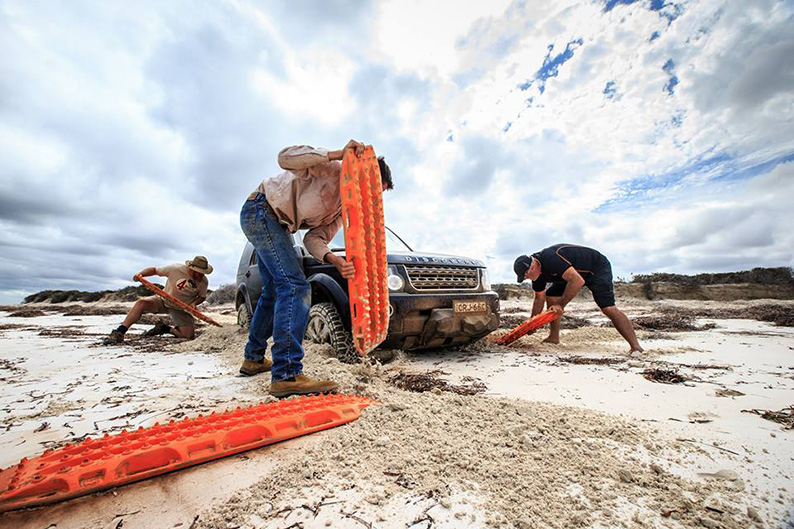Third chapter of our tutorial series dedicated to off-road driving. This time we take a closer look at what you need to bring along with you to explore the world safely.
In the two previous chapters of this off-road for beginners guide, I have tried to explain the importance of preparation – physical, mental, technical, etc… – , and gone over the different types of vehicle you can use. In this article, I’d like to share with you a list of equipment you should always carry with you while traveling off-road.
Now, we live in a society that thrives on consumption, where marketing gurus will have you feel naked unless you possess everything for anything. Through ads, brochures and reviews, they will lead you to believe that you can’t do in life without the latest, the most, the best, the highest, the biggest and the useless. I, too, at first, fell for it, thinking I needed to look like an explorer to explore, convinced my safety, my comfort, worst, my credibility depended on it. And while most “locals” you will meet when exploring remote areas thrive with close to nothing, we feel obligated to carry the world with us to just survive. It not only has a cost, it also has consequences. The heavier you are, the harder it gets to move it. It’s called weight versus performance. Or, how a simple climb can quickly become an Everest because you took too much useless stuffs with you.
Only take with you what you really need. Time and experience will help decide what matters for you.
Required equipment
It goes without saying that everything on that list should be in working order, and that you learn how to use them before you actually need to use them.
General tools
Tool box.
Light.
Fire extinguisher.
Jumper cables.
Crow bar (Handy when having to move rocks out of the way)
Saw.
Tip: If you plan on exploring a forest trail, a chain saw is a needed up-grade. There are only so many branches you can go through in a day with a regular saw.
Recovery

Shovel. (Have a long handle one to reach underneath the car)
Traction plates type Maxtrax.
Jack.
Tip: For those with an after-market lift, make sure you carry a special recovery jack that can go high enough, and toss the original one specified with your car. The original kit is now too short.)
Wood stand.
Tip: For obvious safety reasons, your jack must stand on steady ground. Most will come with a wide base. If not, place it on a large wood base. Don’t ever get underneath a car holding on a simple jack, EVER !
Tow rope.
Tip: Make sure the rope is rated for your vehicle.
2 Tow hooks.
Tip: Again make sure they are rated for the weight of your car. Choose rope ones over metal. Lighter and safer.
Gloves.
Tires
Real spare tire in working order.
Tip: Inspect your spare regularly. Also, Spare tires often come with an anti-theft device requiring a special socket to detach. Don’t forget the socket at home !
Tire puncture kit.
Air compressor.
Air pressure gage.
Orientation
GPS.
Local maps.
Compass.
Communication
Radio walkie-talkie.
Tip: For some strange reasons, those are illegal in some countries. Don’t have them sitting obvious when crossing borders. I have left some at the border between Oman and Dubai (Dubai’s side), and I’m still mad about it !
Satellite phone.
Tip: A regular phone is nice, but when you’re going to remote areas, nothing is more precious than a satellite phone. A must !
Spare parts
Fuses.
Engine oil & Oil Filter.
Transmission Oil.
Transfer case oil.
Brake fluid.
Anti-Freeze.
A clean funnel.
Tip: Those liquids, especially the anti-freeze, take a lot of room. I have been bitching about it for ever, but think how sorry you’ll be the day you really need it and left it at home !
Extra 20L metal jerry cans of Gasoline.
Tip: It’s better to store it outside the car. Particularly if you drive a Diesel engine. I spilled some inside the car once two years ago. It’s sticky and the nasty smell never left !
Transmission Cable & related parts.
Tip: No point having the cables if you don’t have the connections to attach it. As a matter of experience it’s often the plastic connectors that break first, not the cable.
Emergency
20 L plastic jerry can for water.
Tip: Have this one inside the car if you can. Plastic directly under the sun isn’t very good. Depending on the type of plastic used it can chemically affect the water.
Non perishable food.
Safety blanket.
Safety kit (medical, anti-venin, etc…)
Camping gears in case you are stranded for a while.
Miscellaneous
A list of all the items you are carrying with you translated in the language of the country you are in. (Very handy during border crossings.)
Your car ‘s specifications translated in the language of the country you are in.
(Very handy when dealing with a local mechanic)
Useful sentences (Where is the nearest gas station ?, etc…)translated in the language of the country you are in.
(Very handy when nobody speaks english !)
It can look like a long list, but apart from the replacement fluids, it doesn’t take much room, and fits in two standard Front-Runner storage boxes. Have all of those organized in a rational manner so you can find them easily, if needed. Nothing worse than having to unload the entire car to get a little replacement fuse !
Next article. Driving !

